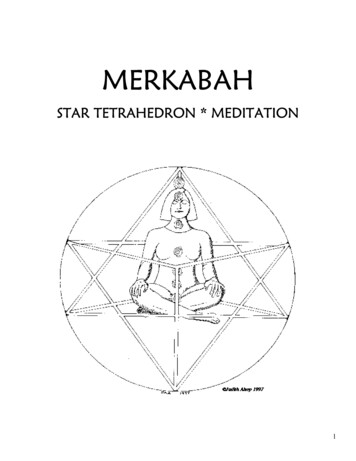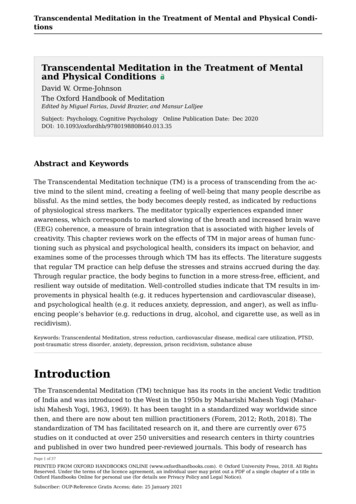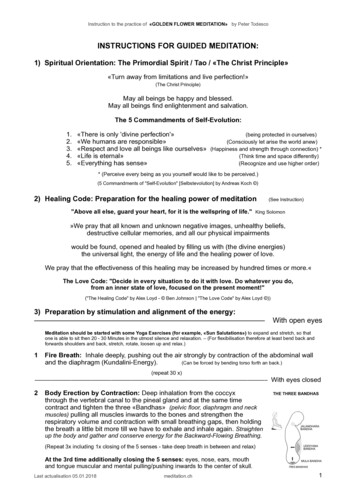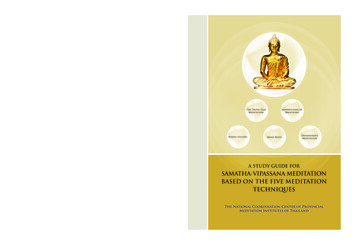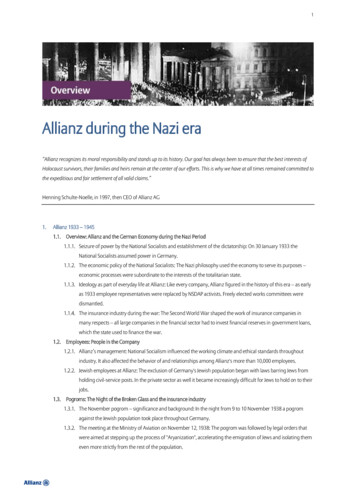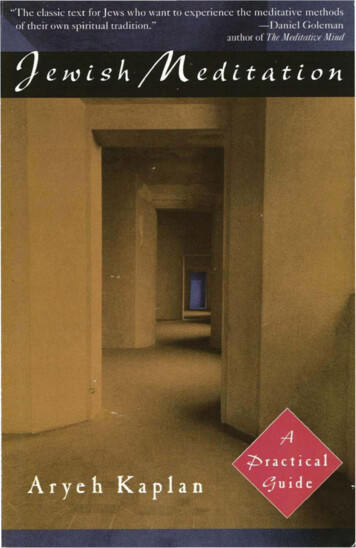
Transcription
A Practical GuideARYEHS C H O C K E NKAPLANBOOKSN E WY O R K
COPYRIGHT 1985 B Y S C H O C K E N B O O K SINC.All rights reserved under International and Pan-AmericanCopyright Conventions. Published in the United States by SchockenBooks Inc., New York. Distributed by Pantheon Books,a division of Random House, Inc., New York.Originally published by Schocken Books in 1985.Library of Congress Cataloging in Publication DataKaplan, AryehJewish meditation: a practical guide1. Meditation(Judaism)1.TitleBM723.K288 1985 2967 84-23589ISBN 0-8052-1037-7The publisher acknowledges with gratitudethe assistance of Mrs. Anita Lasry in the preparation of this book.Manufactured in the United States of America['95]987654321
CONTENTSIntroductionvii1. W h a t Is Meditation?2. W h y M e d i t a t e ?3. T e c h n i q u e s38154. States of Consciousness255. Jewish Meditation406. Mantra Meditation547. Contemplation648. Visualization779. Nothingness8310. Conversing with God11. T h e W a y o f Prayer12. Relating to G o d13. Unification14. T h e L a d d e r929910712213215. In All Your Ways14116. T h e C o m m a n d m e n t s14717. B e t w e e n Man and W o m a n18. Remolding the S e l f161154
INTRODUCTIONPeopleare often surprised to hear the termJewish medita-tion." Otherwise knowledgeable J e w s , including many rabbisand scholars, are not aware that such a thing exists. W h e n showntexts that describe Jewish meditation, they respond that it belongs to esoteric or occult corners of Judaism and has little to dowith mainstream Judaism.It is therefore not surprising that many current books on meditation give scant attention to Judaism. Although most writersseem to be aware that mystical elements exist in Judaism, theirdiscussion is usually restricted to the Kabbalah or the Chasidicmasters. Most books on meditation emphasize Eastern practices,and in some instances Christian meditation, but Jewish meditation is for all practical purposes ignored.F o r students of meditation, this is a serious oversight. Judaismproduced one of the more important systems of meditation, andignoring it is bound to make any study incomplete. F u r t h e r m o r e ,since Judaism is an E a s t e r n religion that migrated to the W e s t ,its meditative practices may well be those most relevant to W e s t ern man. Without a knowledge of Jewish meditative practices, animportant link b e t w e e n E a s t and W e s t is lost. This omission is allthe more significant in light of considerable evidence that theJewish mystical masters had dialogue with the Sufi masters andwere also aware of the schools of India.vii
viiiIntroductionF o r the J e w , however, the lacuna is most serious. Jews areby nature a spiritual people, and many J e w s actively seek spiritual meaning in life, often on a mystical level. Generationsago, large n u m b e r s of Jews were attracted to the mystical traditions of groups such as the F r e e m a s o n s . Today, many American J e w s have b e c o m e involved in Eastern religions. It is estimated that as many as 75 percent of the devotees in someashrams are Jewish, and large percentages follow disciplinessuch as Transcendental Meditation.W h e n I speak to these Jews and ask them why they are exploring other religions instead of their own, they answer that theyknow of nothing deep or spiritually satisfying in Judaism. W h e n Itell them t h e r e is a strong tradition of meditation and mysticism,not only in Judaism, but in mainstream Judaism, they look at measkance. Until J e w s b e c o m e aware of the spiritual richness oftheir own tradition, it is understandable that they will search inother pastures.A few years ago, I was invited to speak in a small synagogue inupstate New York. T h e weather was bad that evening, and onlytwenty people showed up, so instead of giving the lecture I hadplanned, I gathered everyone into a circle and just talked. Mostof the people there had relatively little knowledge of Judaism. Inthe course of our talk, I began to discuss the S h e m a and how itcan be used as a meditation (see chapter 3). O n e of the womenpresent asked if I would do a demonstration, and I agreed.T h e whole meditation could not have taken more than ten orfifteen minutes. Ordinarily, it would have taken longer, but inthis situation I felt pressed for time. Still, at the end, everyonepresent, including m e , was literally breathless. Collectively, wehad e x p e r i e n c e d a significant spiritual high." W h y can't we ever do anything like this at services?" askedone of the men. It was a question I could not answer. T h e discussion turned to how cold and spiritually sterile synagogue servicescan b e , and how a technique like this, which works so well in agroup, could make the service infinitely more meaningful. Tog e t h e r we questioned whether the synagogue service was initially meant to be a meditative experience.
IntroductionixIf finding spiritual meaning is difficult for the uncommittedJ e w , it is sometimes difficult for the Orthodox J e w as well. Ihave b e e n approached by yeshiva students who are committedto observing the rituals of Judaism but fail to see how thesepractices can elevate them spiritually. E v e n more troubling isthe n u m b e r of Orthodox J e w s who are involved in disciplinessuch as Transcendental Meditation. Most of them express uneasiness about these practices but feel that the benefits outweigh the dangers. W h e n asked why they do not seek this typeof e x p e r i e n c e in Judaism, they give the same answer as uncommitted J e w s : they are not aware that such an experience can befound within Judaism.W h e n my first book on the subject, Meditation and the Bible,was published in 1 9 7 8 , it sparked a new interest in Jewish meditation in many circles. F o r most people, it was the first intimationthat Jewish meditation existed. Although the work drew on aconsiderable amount of published material, most of the sourceshad n e v e r b e e n translated from the H e b r e w and were availableonly to e x p e r i e n c e d H e b r a i c scholars. E v e n then, much of thematerial was difficult to understand for someone who had notengaged in meditative practices. To make this material accessib l e , the keys to understanding had to be found, and many ofthese keys existed only in ancient, unpublished manuscripts.It is significant that most of the important texts on Jewishmeditation have never been published, even in their originalH e b r e w . T h e most important works exist only in manuscript,locked away in libraries and museums. To research this book, aswell as a s u b s e q u e n t work, Meditation and Kabbalah, the manuscripts first had to be located; this involved searching throughscholarly journals and library catalogues. O n c e the manuscriptsw e r e found, copies had to be obtained, and when they werelocated in places like the Lenin Library in Moscow, this was notan easy task. Many of the manuscripts were hundreds of yearsold, written in obsolete scripts that could be deciphered onlywith considerable effort. T h e effort was worth it, however, andmany important keys to Jewish meditation were discovered.B e c a u s e so little on Jewish meditation was ever published,
xIntroductionmany people argued that meditation was to be found only in thebackwaters of Judaic literature—in works not even worthy ofpublication. Actually, many works dealing with {Cabbalisticmethods of meditation were not published because the practiceswere dangerous and were not meant for the masses. Still, eventhese works shed considerable light on obscure passages found inpublished mainstream works; they are an integral part of thepuzzle, without which major areas of Judaism are difficult, if notimpossible, to understand. O n c e the puzzle began to c o m e together, it b e c a m e clear to me that some of the most importantmainstream Jewish leaders of the past relied on various meditative techniques.With the publication of Meditation and the Bible, interest inJewish meditation began to grow. E v e n the Lubavitcher R e b b eissued a directive that Jewish forms of meditation should be explored. Groups that taught and practiced Jewish meditation wereformed in the U n i t e d States and Israel. I felt privileged that mybooks formed the basis of many of these groups.Unfortunately, a n u m b e r of groups also involved in "Jewishmeditation" w e r e practicing something far from Judaism. S o m eof them attempted to adapt Eastern practices to Jewish audie n c e s , or to Judaize Eastern teachings. Although these groupsattracted a following of sorts, they were not teaching Jewishmeditation.Meanwhile, together with a group of committed Jewish psychiatrists and psychologists, I began to experiment with the techniques I had found in the literature. T o g e t h e r we explored theinner space of the meditative state. Among the participants wereDavid Sheinkin (of blessed memory), Seymour Applebaum, andPaul (Pinchas) B i n d l e r . O t h e r m e m b e r s who made importantcontributions to the group were Arnie and Roz Gellman, MiriamBenhaim Circlin, Sylvia Katz, Jeff Goldberg, Gerald Epstein,Perle Epstein, and many others.O n e important discovery we madewith Jewish meditation assume thatthe general t e c h n i q u e s , and intenddetail. T h e details w e r e fascinating,was that most texts dealingthe reader is familiar withonly to provide additionalbut when we tried to trans-
Introductionxilate them into practice, we discovered that too much informationwas missing. It was like trying to use a book on advanced F r e n c hcuisine without a rudimentary knowledge of cooking. T h e recipesw e r e t h e r e , but a novice could not use them. In the case ofJewish meditation, the ingredients were there, but the means ofmixing t h e m t o g e t h e r were omitted or glossed over.To some d e g r e e , the puzzle was pieced together in my twoprevious meditation books. However, neither of these books wasmeant to be a practical guide. Many people expressed the needfor a guide to Jewish meditation written in nontechnical terms forthe layperson. It was out of these requests that the idea for thisbook was born.This book presents the most basic forms of Jewish meditation,especially as discussed in mainstream sources. It assumes nospecial background on the part of the reader either in Judaism orin meditation. It is my hope that this book will at least begin toprovide its readers with insight into the spiritual dimensions ofthe Jewish heritage.Aryeh KaplanD e c e m b e r 17, 1982
1WHAT IS MEDITATION?Whatis meditation? F o r someone who has been involved inthe practice, the question need not be asked. F o r a person whohas n e v e r had any contact with meditation, however, the subjectis shrouded in mystery. To many people, the term "meditation"suggests an image of someone sitting in the lotus position witheyes closed in s e r e n e concentration. Others may associate meditation with holiness and spirituality. Individuals seeking spirituality might look into various disciplines of meditation withouthaving any idea of what they are looking for.In its most general sense, meditation consists of thinking in acontrolled manner. It is deciding exactly how one wishes to direct the mind for a period of time, and then doing it.In theory this may sound very easy, but in practice it is not.T h e human mind is not a domesticated animal, but rather seemsto have a mind of its own beyond the will of the thinker. Anyonewho has ever tried to concentrate on a subject, only to have hismind drift to other thoughts, is aware of this. Sometimes it seemsthat the more one tries to control one's thoughts, the more theyrefuse to be controlled.It is strange that most people have never given a thought totheir thoughts. Thoughts are so much part of our being that wetake them for granted. O n e of the first steps in meditation islearning how not to take our thoughts for granted.3
4Jewish MeditationA simple exercise will demonstrate how difficult it is to controlyour thoughts. In theory this exercise seems ridiculously simple,but in practice it is tantalizingly difficult.This is the exercise: Stop thinking.Normally, when one is not otherwise occupied, there is a constant flow of thought passing through the mind. In this reverie,one thought flows into another, almost automatically. This flow ofthought goes on and on, like an internal conversation with oneself. Usually, this reverie is so much part of our mental environment that we do not pay attention to it.T h e first exercise is to b e c o m e aware of your thoughts by tryingto stop them. T r y to blank out your mind for a few minutes andnot think of anything at all. Sound easy? Stop reading now andtry it.All right. How long did it last? Unless you are very unusual,or have had meditative experience, you could not keep yourmind blank for more than a few seconds. If nothing more, theperiod of mental silence was probably interrupted by thethought, "I'm not thinking," or "I'm trying not to think." Inpractice, it is e x t r e m e l y difficult to turn off thought. As we shallsee, control over the thought process is one of the goals of somemeditative disciplines.T h e r e is another way in which you can try to control yourmind. W h e n you finish this paragraph, close your eyes. You willprobably see lights or images flashing before your eyes. Giveyourself a few m o m e n t s to relax, and these flashing lights willsubside and develop into a series of kaleidoscopic images in themind's eye. T h e s e images will arise and change spontaneouslywith little or no direction by the conscious mind. O n e imageflows into another as still another grows and develops. It is almostimpossible to concentrate on these mind-begotten images, because when you try, they disappear.Now, with your eyes closed, try to control these images. Try todepict the letter A in your mind's eye. Unless you have practicedthis technique for some time, it is impossible to hold on to thisimage.O n e of the t e c h n i q u e s of meditation is "imaging," evoking an
What Is Meditation?5image in the mind's eye and holding it there. In Jewish meditation, this is known as "engraving." H e r e the image is fixed in themind as if it were engraved, so that it can be held in the mind aslong as one desires. This technique can be perfected onlythrough extensive training.Having tried these two exercises, you can see that the mindhas a "mind of its own." T h e r e are thus two parts to the mind,one that is under the control of the conscious will and one thatis not. That part of the mind under the control of the will iscalled t h e consciousness, while that which is not is called theunconscious or subconscious. Since the subconscious is notunder the control of the will, one cannot control what it passesinto the conscious mind.O n e of the goals of meditation, then, is to gain control of thesubconscious part of the mind. If one were to succeed, one wouldalso gain a high degree of self-mastery. This, too, is a goal ofmeditation.This explains why so many disciplines use breathing exercisesas a meditative device. Breathing usually occurs automaticallyand is therefore normally under the control of the unconsciousmind. Unless you are consciously controlling your breathing, itwill mirror your unconscious mood. This is one reason whybreathing is one of the indicators in a lie detector test.Yet, if you wish, you can control your breath, and do so quiteeasily. B r e a t h i n g therefore forms a link between the consciousmind and the unconscious. By learning how to concentrate onand control your breath you can go on to learn how to control theunconscious mind.T h e thought process itself is also controlled to a large degreeby the unconscious, but it can also be controlled by the consciousmind. This is most obvious in the case of the reverie. W h e n oneis relaxing and not paying particular attention to it, the reverieflows from one thought to another without conscious effort. Indeed, there are a n u m b e r of psychological techniques that try toimitate this "free association," in order to gain an understandingof the unconscious mind. However, no matter how free the association may be when one is expressing it to a second party, it is
6Jewish Meditationn e v e r as free as in the case of pure reverie. T h e reverie thus canalso be seen as a point of interface b e t w e e n the conscious andunconscious. By learning how to control the reverie, one can alsolearn how to control the unconscious.T h e same is true of the visions that appear in the mind's eye.Since they are not under the control of the conscious mind, theyare obviously coming from the unconscious. Controlling them isvery difficult without practice; one can learn to control them,however, and doing so also serves to form a bridge between theconscious mind and the unconscious.O n e of the most powerful benefits of meditation is control overthe unconscious mind. O n e learns to use the conscious mind tocontrol mental processes that are usually under the control of theunconscious. Gradually, more and more of the subconscious becomes accessible to the conscious mind, and one gains control ofthe entire thought process.S o m e t i m e s , different parts of the mind appear to be actingindependently. T h e conflict b e t w e e n two parts of the mind canbe so strong that a person feels like two separate individuals.During such inner conflict, it seems that one part of the mindwants to do one thing, while the other part wants to do something else.Thus, for example, a person may be drawn toward a sexualtemptation. O n e part of the mind is thus saying yes very loudly.Yet, at the same time, another part of the mind may feel that theact is morally reprehensible. This second part of the mind may besaying no with equal loudness. T h e person may feel caught in themiddle, b e t w e e n the two voices.In classical Freudian psychology, this would be seen as aconflict b e t w e e n the id and the superego. In our example, theid would be saying yes to the temptation, while the superegowould be saying no. Somehow, the ego (the "I") mediates between these two subconscious voices. Although Freud's schematies it into a neat package, introspection shows that the conflictis actually more complex than the simple picture of the id andsuperego. S o m e t i m e s not two but three, four, or more voicesseem to be giving different signals in the mind. If a person were
What Is Meditation?7to learn to control his subconscious, he could avoid much of thisconflict.T h e r e are many theories about the subconscious, and a fulldiscussion is far beyond the scope of this book. However, ifmeditation is controlled thinking, it implies that the individualhas the entire thought process under control, including inputfrom the subconscious. T h e experienced meditator learns how tothink what he wants to think, when he wants to think it. He canalways be in control of the situation, resisting psychological pressures that work on the subconscious. He is also in control ofhimself, n e v e r doing something that he knows he really does notwant to do. In many schools, this self-mastery is one of the mostimportant goals of meditation.
WHY MEDITATE?M e d i t a t i o n , which is thought directed by will, can bringmany benefits. Most people learn how to think as very youngchildren, and throughout their adult lives, they do not think anydifferently than they did as children. That is to say, most peopleuse their minds in a manner not essentially different from theway they did when they were six years old. Through meditation,one can control the thought process and learn to think in newways, thus gaining new and richer mind experiences.It is significant that in Kabbalah, one's normal mode ofthinking is referred to as the "mentality of childhood" (mochinde-katnuth). M o r e advanced modes of thought and states ofconsciousness, on the other hand, are referred to as the "mentality of adulthood" (mochin de-gadluth). O n e learns thesemethods of "adult thought" through meditation, through whichone develops the ability to transcend the ways of thinking onelearned as a child.In chapter 1, for example, we discussed how different parts ofthe mind act independently. Thus, a person might want to concentrate on a task at hand, but at the same time other concernspop into his mind, disturbing his concentration. W h i l e one partof the mind is trying to focus on a problem, other parts may bedrawing attention to different ideas. As long as this is true, concentration is not c o m p l e t e .
Why Meditate?gF o r this reason, a person usually uses only a small portion ofthe mind. As much as he might try to concentrate on a thought ortask, parts of his mind are engaged in other activities. Sometimesthe rest of the mind is merely passive. At other times however,other parts of the mind may actually be acting in opposition toone's concentration. Unless one is able to control the entiremind, o n e cannot develop full concentration.People often think of concentration in terms of problem-solving. It can also involve the most basic of experiences. Suppose,for example, that you are trying to experience the beauty of arose. At the same time, thoughts about your business may bepushing their way into your mind. Your attention does not stayfocused on the rose and you cannot see the rose totally, in all itsbeauty.B u t t h e r e is another factor that prevents you from experiencingthe rose completely. Earlier, we discussed the spontaneous images that arise in the field of vision when the eyes are closed.Actually, you can also see these images with your eyes open in adarkened room. O n c e you are aware of these images, you caneven see them with your eyes open in a well-lit room. T h e reasonyou are normally not aware of these images is that they are veryfaint compared with the images entering your mind from youropen eyes. Nevertheless, they are constantly with you.Now suppose you are trying to appreciate the beauty of a rose.No matter how hard you try to focus your mind on the rose, theimage of the rose is competing with the self-generated images inthe mind. It is as if there were a screen of extraneous imageryb e t w e e n you and the rose, preventing you from seeing it withtotal clarity.In a meditative state, however, it is possible to turn off theinterference and concentrate totally on the rose. As we shall see,with training, o n e can turn off the spontaneous self-generatedimages and thus remove the screen. T h e beauty of the flowerwhen seen in these higher states of awareness is indescribable tosomeone who has never experienced it. T h e most I can say is thatthe rose actually appears to radiate beauty. This can be true ofanything else in the world.
1oJewishMeditationAnother important goal of meditation is thus enhanced awareness and perception. T h e greater the portion of the mind focusedon an e x p e r i e n c e , the more the experience will be enhanced.W h e n every cell in your brain is tuned in to experiencing therose, the experience is indescribably different from what youwould see in your usual state of consciousness.This works in one of two ways. T h e most simple way in whichmeditation works is to quiet down all parts of the mind not concentrating on the immediate e x p e r i e n c e . In this mode, the experience is not e n h a n c e d directly, but rather all interference with itis removed. Thus, you may be looking at the rose with no greaterawareness than before, but without the mental static, it will appear much more vivid. It is somewhat like trying to tune in to afaint radio station; even if you cannot amplify the volume, youwill hear the station more clearly if you can eliminate the static.This mode of meditation can be reached through most meditativetechniques and is the state of consciousness most readily attainable in its lower levels.T h e second way in which meditation can enhance an experie n c e is by focusing more of the mind on it. Ultimately, as oneb e c o m e s a more experienced meditator, one can learn to focusthe entire mind on a single experience. This is analogous toturning up the volume of a radio or using a system of greaterfidelity. This level is attained in the more advanced states ofmeditation, and one can use it to exert the total force of one'smind on anything one desires.Of course, n e i t h e r mode is generally attained without theother. W h e n you quiet other areas of the mind, you also focusmore of the mind on the experience. Conversely, focusing moreof the mind on the experience almost always involves blockingout other experiences and thoughts.This increased awareness can be used in many ways. Meditation can be used to gain a greater and clearer awareness of theworld around us. Looking at something like a rose while in ameditative state of consciousness, one can see much more in itthan one would otherwise see. It has b e e n said that one can see
Why Meditate?11the entire universe in a grain of sand. In a high meditative state,this is actually possible. As one's capacity for concentration increases, one can also b e c o m e aware of subtle phenomena that arenot otherwise detectable. Thus, the world of the meditator mayb e c o m e much richer than that of those who have never had theexperience.H e r e again, there is a language barrier. If one has never experienced these phenomena, then one cannot comprehend a description of them. T h e situation can be better understoodthrough analogy.F o r the average sighted person, a page of braille feels likebumpy paper and nothing more. A blind person, however, doesnot have his sense of sight competing with his sense of touch, andh e n c e experiences less "static." F u r t h e r m o r e , since he uses hissense of touch more often, his tactile sense is enhanced. Withpractice, he learns to decipher the patterns of raised dots asletters and words. It is true that a sighted person can also learn toread braille, but those who have mastered it usually read withtheir eyes closed, so that their faculty of sight will not interferewith their sense of touch.Reading braille is a good example of an experience that ismeaningless to a nonsensitized person but has a world ofmeaning for a sensitized person. Many such experiences mayexist in the world, and meditation can teach one to "read"these messages.Another analogy may express this even more clearly. Manyblind people learn to navigate by listening to the subliminalechoes given off by buildings and other large objects. This is whyblind people often tap their canes constantly; they listen to theechoes produced by the tapping, and the echoes warn them ofobstructions. T h e strange thing is that blind people claim thatthey do not actually hear these echoes, but sense them in amanner that they cannot describe. Rather than speak of thise x p e r i e n c e as hearing an e c h o , a blind person will describe it assensing an obstruction. T h e s e echoes are not perceptible to asighted person since the flood of information experienced
12Jewish Meditationthrough vision overwhelms them completely. Moreover, there isa learning period during which a blind person b e c o m e s sensitized to these e c h o e s .On a more esoteric level, in Tibetan medicine, as well as inKabbalah, a n u m b e r of illnesses can be diagnosed merely byfeeling the pulse. T h e subtle differences in the feel and rhythm ofthe pulse can provide a skilled practitioner with a picture of thebody's state of health with uncanny accuracy. Observing theDalai Lama's personal physician make such a diagnosis, a famousdoctor reported that he had witnessed something bordering onthe supernatural.T h e secret, however, is twofold. First, the practitioner mustlearn to e n t e r a d e e p state of concentration in which the pulsebeat fills his entire world of sensation and the subtlest variationsin it stand out clearly and vividly. T h e practitioner is thus able togarner a great deal of information from the pulse beat. To him,every pulse beat is an encyclopedia of information about thebody. O n c e he learns how to "read" the pulse beat in this manner, he can then learn what every variation means. People whohave attempted to learn this technique report that it can take asmuch as fifteen years to master it well enough to make an accurate diagnosis.A n u m b e r of Judaic sources speak of meditation as a means ofattaining extrasensory perception ( E S P ) in such areas as telepathy,mind-reading, clairvoyance, and predicting the future. T h e s epowers may also involve increased awareness. In the ordinarystate of consciousness, E S P signals received by the mind may beovershadowed by the perceptual information entering the brain,as well as by the mind's natural "static" or "noise." As discussedearlier, this static consists of thoughts and images spontaneouslyproduced by the mind which are not under the conscious mind'scontrol. In the meditative state, when this noise or static is quieted, E S P p h e n o m e n a may b e c o m e more readily discernible. An u m b e r of E S P experiments appear to indicate that this is true,and that meditation enhances the effect. Unfortunately, as in thecase of most E S P experiments, results depend on so many variables that unambiguous conclusions are difficult to obtain.
Why Meditate?13Another purpose of meditation is to attune the mind to certaintruths (or Truths with a capital T). W h e n a person tries to explorequestions such as the meaning of existence, the true goal of life,or the ultimate nature of reality, the answers remain elusive,tickling the edge of the mind. Possible answers hover on theborderline of consciousness, but are so subtle that they cannot bediscerned through the static of the mind.O n e of t h e most elusive truths is knowledge of the self. G e n e r ally we see ourselves only through a thick veil of ego. F o r thisre
Kaplan, Aryeh Jewish meditation: a practical guide 1. Meditation(Judaism) 1.Title BM723.K288 1985 2967 84-23589 ISBN 0-8052-1037-7 . When my first book on the subject, Meditation and the Bible, was published in 1978, it sparked a new interest in Jewish medi-tation in many circles. For most people, it was the first intimation .File Size: 1MB

